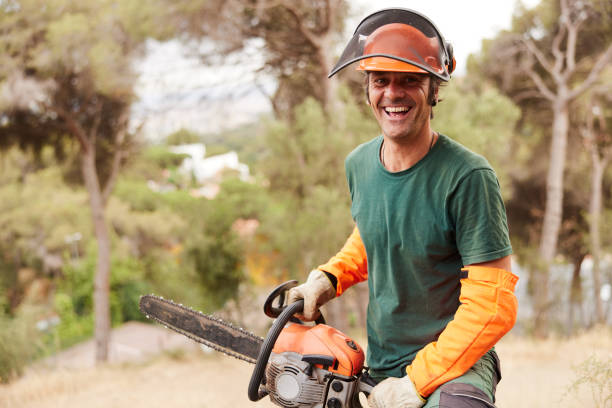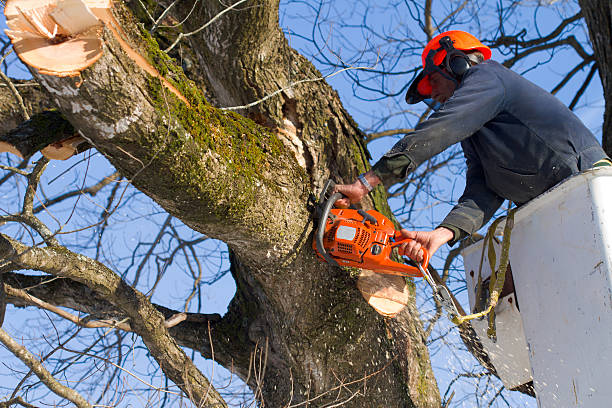Trees are a major part of our lives. They supply us with life-sustaining oxygen and help prevent soil erosion. However, some trees are more life-takers than life-givers.
Learning how to recognize dangerous trees can help you protect your landscape and avoid potential accidents. Inspecting trees regularly is the best way to avoid a disaster.

Damaged or Broken Branches
Trees are wondrous natural specimens that elevate any Clarksville property’s curbside appeal, but they can also pose a risk to people or pets who walk on your property. By learning the signs of a dangerous tree, you can ensure your family and visitors stay safe.
The first sign of a potentially hazardous tree is the presence of large broken branches, especially those on the ground. Even if the branch isn’t on a power line or near your home, it should still be removed by a dangerous tree removal because of its size and weight. These heavy branches can fall with little notice and cause serious damage if they land on your house or car.
A second sign of a potentially dangerous tree is visible structural defects in the trunk or main limbs. Soft spots in the trunk of a tree indicate that it is rotting from the inside, which is a serious threat to health and safety.
Other structural defects to look out for include vertical cracks, seams or dead branch stubs, which suggest that the trunk is weakening from within and may soon break. Fungi in the trunk of a tree are another early warning sign and should be professionally removed to prevent infection throughout the entire tree. In addition, if the roots of a tree are damaged, it is likely to be a hazard and should be examined by Oz Tree Services.
Leaning Trees
Leaning trees are a common concern for many homeowners. Whether or not a leaning tree is dangerous primarily depends on how it developed. A tree that naturally develops a lean due to its species and inclination toward light sources is unlikely to pose a safety risk.
However, a leaning tree that develops suddenly is more concerning and likely a sign of significant damage or disease within the trunk and root system. This type of damage can shift the tree’s center of gravity and make it more unstable.
A lateral lean in a healthy tree can be re-stabilized by installing bracing cables. If a lateral lean has been caused by construction trauma, a shallow root system or physical injury to the roots, or is increasing in severity over time, it may need to be removed entirely.
Keep in mind that the best way to prevent a dangerous tree is through regular monitoring of all trees on your property, especially during adverse weather conditions or after storms. Regular pruning, including removing dead or dying branches, can also play a crucial role in minimizing the risks of leaning and other structural concerns. However, if you notice a sudden increase or change in a tree’s lean or its general condition, do not hesitate to call Greensborough tree removal services for a thorough inspection and evaluation.

Dead or Damaged Trees
Trees are the life-givers of our planet. They help us breathe by absorbing carbon dioxide and then releasing oxygen, they prevent soil erosion that can lead to deadly landslides and even give us our drinking water when they anchor forested watersheds. But, like any living thing, a few dangerous trees do exist. A few trees are life-takers rather than life-givers, and it’s important to recognize the signs of these trees as early as possible so that they can be removed before a fatal accident occurs.
The first step in evaluating the health of a tree is to inspect it regularly. It’s best to inspect all the trees on your property at least once per year but this is especially important during fall and spring when the weather is drier. Inspect for dead branches or limbs that have fallen from the tree and are still attached to it as well as for cracks, splits, and other damage on the trunk and base of the tree.
Another great way to evaluate a tree is to take a look at its bark. A healthy tree will produce smooth, unblemished bark, while a dying one may have holes or cracks in the bark and wood that’s crumbling away or showing signs of insect infestation. Lastly, the presence of fungus on a tree’s trunk or base is also a sign that it may be dying and should be examined by an arborist immediately.
Trees Near Powerlines or Walkways
Unless they’re part of your landscape design, don’t put any living or dead trees within striking distance of powerlines or walkways. A tree that’s growing too close to a powerline can spark and cause a fire, or its branches may hit the lines and interrupt electricity flow. Electricity can also jump from the line to a nearby tree, causing serious injury or death.
Even a single touch from the manchineel tree (Hippomane mancinella) of Florida and the Caribbean can cause blisters, and a bite from the small green apple-like fruit can be fatal. But despite its dangers, the plant isn’t a pest – it provides valuable ecosystem services. It’s a natural windbreak, fights beach erosion and helps keep mosquitoes away, among other things. Its biotoxins have even inspired beneficial scientific breakthroughs, such as safer insecticides from scorpion venom and pain medicine from cone snails.
The best way to avoid hazard symptoms is through regular professional maintenance, including corrective pruning and crown reduction to maintain a balanced, open tree canopy. Keeping targets out of the tree’s hazard range, such as playground equipment and parked cars, can also reduce the risk. But if you notice any of the warning signs, call a skilled vegetation management professional right away to help prevent damage and injuries.